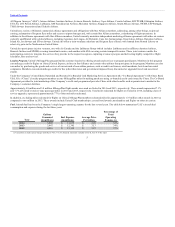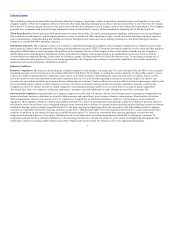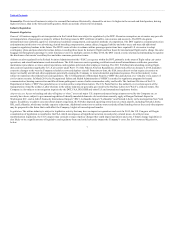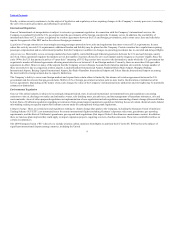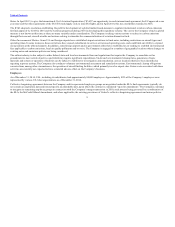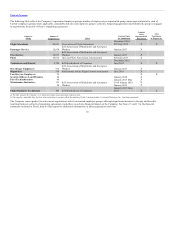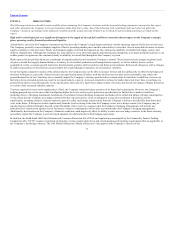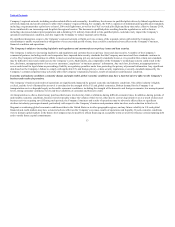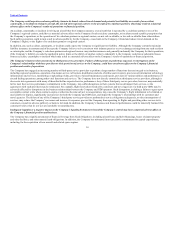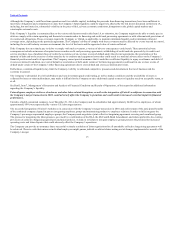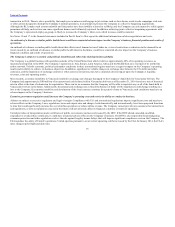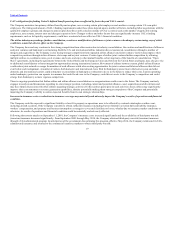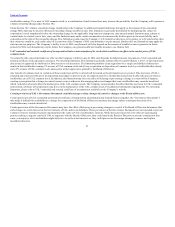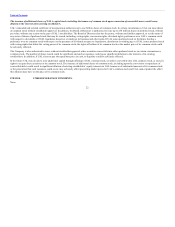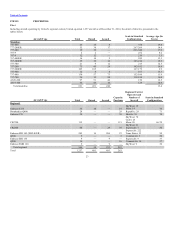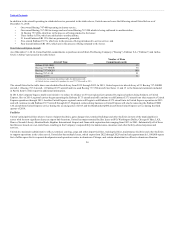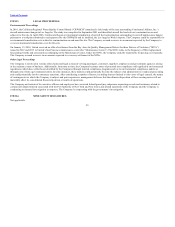United Airlines 2014 Annual Report Download - page 15
Download and view the complete annual report
Please find page 15 of the 2014 United Airlines annual report below. You can navigate through the pages in the report by either clicking on the pages listed below, or by using the keyword search tool below to find specific information within the annual report.
Table of Contents
Although the Company’s cash flows from operations and its available capital, including the proceeds from financing transactions, have been sufficient to
meet these obligations and commitments to date, the Company’s future liquidity could be negatively affected by the risk factors discussed in this Item 1A.,
including, but not limited to, substantial volatility in the price of fuel, adverse economic conditions, disruptions in the global capital markets and
catastrophic external events.
If the Company’s liquidity is constrained due to the various risk factors noted in this Item 1A. or otherwise, the Company might not be able to timely pay its
debts or comply with certain operating and financial covenants under its financing and credit card processing agreements or with other material provisions of
its contractual obligations. These covenants require the Company or United, as applicable, to maintain minimum liquidity and/or minimum collateral
coverage ratios, depending on the particular agreement. The Company’s ability to comply with these covenants may be affected by events beyond its control,
including the overall industry revenue environment, the level of fuel costs and the appraised value of certain collateral.
If the Company does not timely pay its debts or comply with such covenants, a variety of adverse consequences could result. These potential adverse
consequences include an increase of required reserves under credit card processing agreements, withholding of credit card sale proceeds by its credit card
service providers, loss of undrawn lines of credit, the occurrence of one or more events of default under the relevant agreements, the acceleration of the
maturity of debt and/or the exercise of other remedies by its creditors and equipment lessors that could result in a material adverse effect on the Company’s
financial position and results of operations. The Company cannot provide assurance that it would have sufficient liquidity to repay or refinance such debt if
it were accelerated. In addition, an event of default or acceleration of debt under certain of its financing agreements could result in one or more events of
default under certain of the Company’s other financing agreements due to cross default and cross acceleration provisions.
Furthermore, constrained liquidity may limit the Company’s ability to withstand competitive pressures and downturns in the travel business and the
economy in general.
The Company’s substantial level of indebtedness and non-investment grade credit rating, as well as market conditions and the availability of assets as
collateral for loans or other indebtedness, may make it difficult for the Company to raise additional capital to meet its liquidity needs on acceptable terms, or
at all.
See Part II, Item 7, Management’s Discussion and Analysis of Financial Condition and Results of Operations, of this report for additional information
regarding the Company’s liquidity.
Union disputes, employee strikes or slowdowns, and other labor-related disruptions, as well as the integration of United’s workforces in connection with
the Company’s merger transaction in 2010, could adversely affect the Company’s operations and could result in increased costs that impair its financial
performance.
United is a highly unionized company. As of December 31, 2014, the Company and its subsidiaries had approximately 84,000 active employees, of whom
approximately 80% were represented by various U.S. labor organizations.
The successful integration of United’s workforces in connection with the Company’s merger transaction in 2010 and achievement of the anticipated benefits
of the combined company depend in part on integrating employee groups and maintaining productive employee relations. In order to fully integrate the
Company’s pre-merger represented employee groups, the Company must negotiate a joint collective bargaining agreement covering each combined group.
The process for integrating the labor groups is governed by a combination of the RLA, the McCaskill-Bond Amendment, and where applicable, the existing
provisions of collective bargaining agreements and union policies. A delay in or failure to integrate employee groups presents the potential for increased
operating costs and labor disputes that could adversely affect the Company’s operations.
The Company can provide no assurance that a successful or timely resolution of labor negotiations for all amendable collective bargaining agreements will
be achieved. There is a risk that unions or individual employees might pursue judicial or arbitral claims arising out of changes implemented as a result of the
Company’s merger
15


